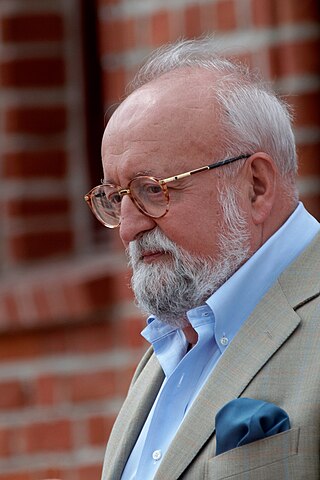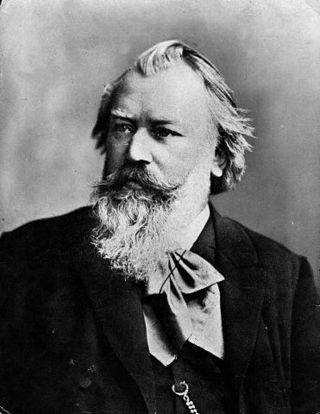Related Research Articles

Krzysztof Eugeniusz Penderecki was a Polish composer and conductor. His best-known works include Threnody to the Victims of Hiroshima, Symphony No. 3, his St Luke Passion, Polish Requiem, Anaklasis and Utrenja. His oeuvre includes four operas, eight symphonies and other orchestral pieces, a variety of instrumental concertos, choral settings of mainly religious texts, as well as chamber and instrumental works.
Dmitri Shostakovich wrote his Cello Concerto No. 2, Op. 126, in 1966 in the Crimea. Like the first concerto, it was written for Mstislav Rostropovich, who gave the premiere in Moscow under Yevgeny Svetlanov on 25 September 1966 at the composer's 60th birthday concert. The concerto is sometimes listed as in the key of G, but the score gives no such indication.

The Double Concerto in A minor, Op. 102, by Johannes Brahms is a concerto for violin, cello and orchestra. The orchestra consists of 2 flutes, 2 oboes, 2 clarinets, 2 bassoons, 4 horns, 2 trumpets, timpani and strings.
Ralph Vaughan Williams dedicated his Symphony No. 4 in F minor to Arnold Bax.

The Barjansky Stradivarius of c.1690 is an antique cello fabricated by the Italian Cremonese luthier Antonio Stradivari (1644-1737).

The Symphony No. 3 is a symphony in five movements composed between 1988 and 1995 by Krzysztof Penderecki. It was commissioned and completed for the centenary of the Munich Philharmonic. Its earliest version, Passacaglia and Rondo, premiered at the International Music Festival Week in Lucerne, Switzerland, on August 20, 1988. It was performed by the Lucerne Festival Orchestra and conducted by Penderecki. The full symphony premiered in Munich on 8 December 1995, performed by the Munich Philharmonic, again conducted by the composer.

Krzysztof Penderecki wrote his Seventh Symphony, subtitled "Seven Gates of Jerusalem", in 1996 to commemorate the third millennium of the city of Jerusalem. Originally conceived as an oratorio, this choral symphony was premièred in Jerusalem in January 1997; it was only after the first Polish performance two months later that Penderecki decided to call it a symphony. It is written for two sopranos, alto, tenor, bass, narrator, chorus and orchestra.
The International Classical Music Awards (ICMA) are music awards first awarded 6 April 2011. ICMA replace the Cannes Classical Awards formerly awarded at MIDEM. The jury consists of music critics of magazines Andante, Crescendo, Fono Forum, Gramofon, Kultura, Musica, Musik & Theater, Opera, Pizzicato, Rondo Classic, Scherzo, with radio stations MDR Kultur (Germany), Orpheus Radio 99.2FM (Russia), Radio 100,7 (Luxembourg), the International Music and Media Centre (IMZ) (Austria), website Resmusica.com (France) and radio Classic (Finland).

Anaklasis is a composition for 42 string instruments and percussion, composed in 1960 by the Polish composer Krzysztof Penderecki. It was first performed at the Donaueschingen Festival in 1960. At this first performance, it was well received by the audience who demanded an encore.
Fantaisie for piano and orchestra (L.73/CD.72), is a composition for piano and orchestra by French composer Claude Debussy. It was composed between October 1889 and April 1890, but only received its first public performance in 1919, a year after Debussy's death. The work is dedicated to the pianist René Chansarel, who had been scheduled to play the solo part for the cancelled premiere in 1890.

The Symphony No. 1 by Polish composer Krzysztof Penderecki was composed in 1973. It was published by Polish Music Publishing House and Schott Music and has never been expanded or revised.
Fonogrammi, for flute and chamber orchestra, is a composition by Polish composer Krzysztof Penderecki. It was finished in 1961 and was published by Schott Music, even though it remained initially unpublished.

The Dream of Jacob, also referred to as The Awakening of Jacob, is a composition by Polish composer Krzysztof Penderecki. It is scored for large orchestra and was finished in 1974.
The Capriccio for Violin and Orchestra is a composition by Polish composer Krzysztof Penderecki. It is one of the five caprices that he composed and one of the two that he composed for a soloist with an orchestra, together with the Capriccio for Oboe and Eleven Instruments.
Krzysztof Penderecki's Cello Concerto No. 1, also known by its original Italian title Concerto per violoncello ed orchestra, Nr. 1, is a revised version of Penderecki's Concerto per violino grande e orchestra, which was never published nor recorded. It was transcribed for cello in 1973.
Three Miniatures for Clarinet and Piano is an early work by Polish composer Krzysztof Penderecki. It was finished in 1956, but was premiered four years later.

Krzysztof Penderecki's setting of the biblical canticle Magnificat was commissioned for the 1,200th anniversary of Salzburg Cathedral and premiered there on 17 August 1974 under the composer's baton. It is a vast work, being scored for bass vocal soloist, boys’ voices, seven other men’s voices, two 24-part mixed choirs and orchestra.

Jean-Marc Fessard is a French classical clarinetist.

The Concerto for Viola and Orchestra is a viola concerto by Soviet and German composer Alfred Schnittke. It was written in the summer of 1985. Its dedicatee is viola player Yuri Bashmet, who gave the work its world premiere with the Royal Concertgebouw Orchestra conducted by Lukas Vis at the Concertgebouw in Amsterdam on 9 January 1986.
References
- 1 2 "Penderecki: Orchestral Works". WarnerClassics.com. Warner Classics. Archived from the original on February 22, 2014. Retrieved February 8, 2014.
- 1 2 "Blue" Gene Tyranny. "Partita, for harpsichord, electric guitar, bass guitar, harp, double-bass & orchestra". Allmusic.com. Rovi Corporation. Retrieved February 8, 2014.
- 1 2 Penderecki, Krzysztof. "Partita für konzertierendes Cembalo, elektrische Gitarre, Bassgitarre, Harfe, Kontrabass und Orchester". Schott-music.com. Schott Music. Retrieved February 8, 2014.
- ↑ Lindeman, Stephan D. (2006). The Concerto: A Research and Information Guide. New York: Taylor & Francis Group. p. 412. ISBN 978-0-415-97619-0 . Retrieved February 8, 2014.
- 1 2 3 4 "Partita for harpsichord, electric guitar, bass-guitar, harp, double bass and orchestra". Narodowy Instytut Audiowizualny. Retrieved February 8, 2014.
- ↑ Whitehouse, Richard. "PENDERECKI, K.: Fonogrammi / Horn Concerto / Partita / The Awakening of Jacob / Anaklasis / De natura sonoris No. 1 (Warsaw Philharmonic, Wit) – Liner Notes". Naxos.com. Naxos Digital Services. Retrieved February 8, 2014.
- ↑ McGill, Raymond (2004). Penderecki - Cello Concerto No. 2 - Partita - Stabat Mater (Liner Notes of Apex 2564 61932-2). Warner Classics. p. 3.
- ↑ "Penderecki* : Rostropovich*, Philharmonia Orchestra, Sinfonieorchester Des Südwestfunks – Concerto N° 2 Pour Violoncelle · Partita". Discogs. 1987. Retrieved February 8, 2014.
- ↑ "PENDERECKI, K.: Fonogrammi / Horn Concerto / Partita / The Awakening of Jacob / Anaklasis / De natura sonoris No. 1 (Warsaw Philharmonic, Wit)". Hong Kong: Naxos Digital Services. 2012. Retrieved February 8, 2014.